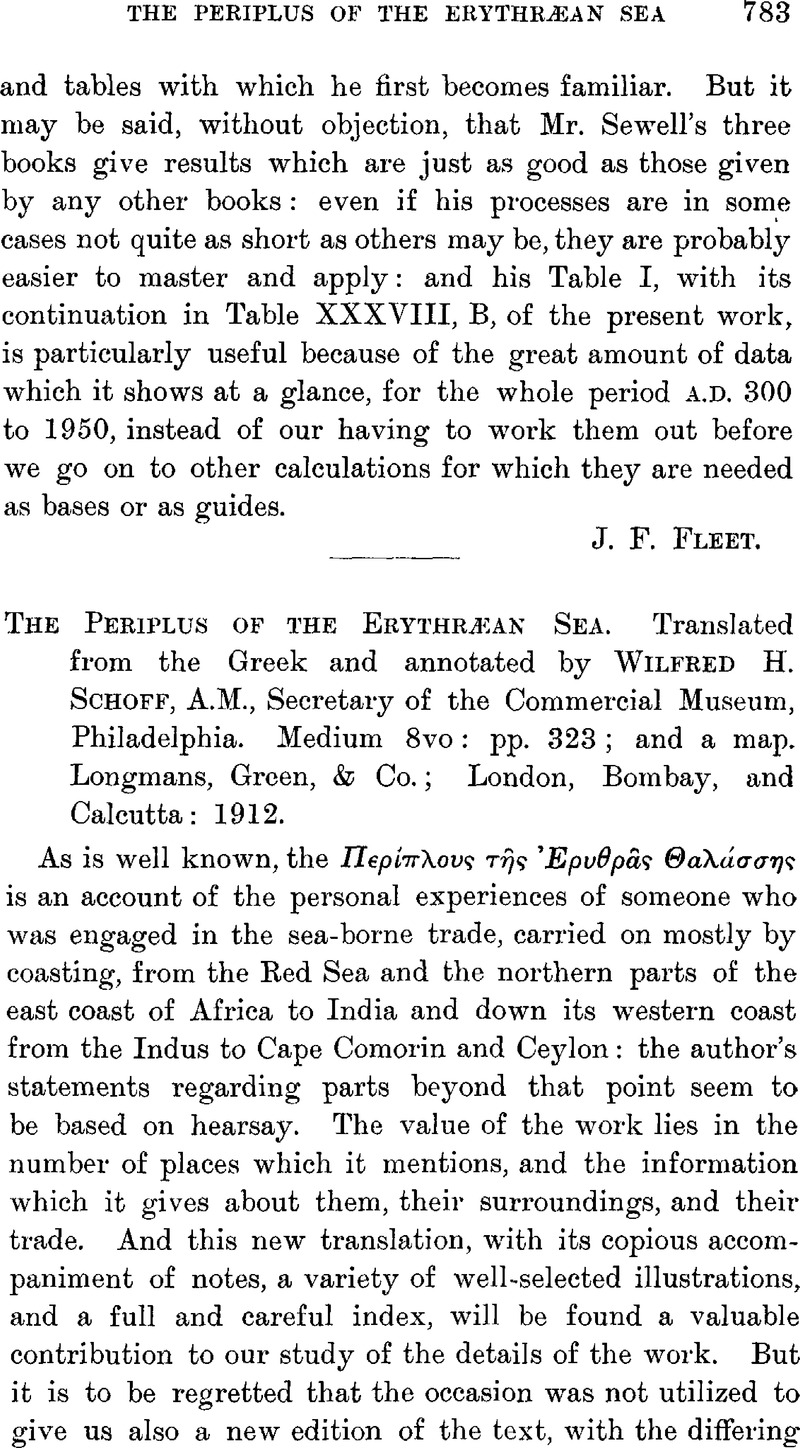No CrossRef data available.
Article contents
The Periplus of the Erythræan Sea. Translated from the Greek and annotated by Wilfred H. SchoffA.M., Secretary of the Commercial Museum, Philadelphia. Medium 8vo: pp. 323; and a map. Longmans, Green, & Co.; London, Bombay, and Calcutta: 1912.
Published online by Cambridge University Press: 15 March 2011
Abstract

- Type
- Notices of Books
- Information
- Copyright
- Copyright © The Royal Asiatic Society 1912
References
page 784 note 1 It was also republished separately, in the same year, with a translation of Arrian's Account of the Voyage of Nearkhos.
page 785 note 1 See fully, the quotation from § 52 on p. 789 below.
page 785 note 2 It can only be by a slip of the pen that Mr. McCrindle presented this name as “Mombaros”, with o (instead of a) in the first syllable: see this Journal, 1907. 1043, note 1. In fact, on a subsequent occasion, in Ind. Ant., 13. 325, he used the form “Mambares”.
page 785 note 3 On some of his coins his name appears as ![]() , with omission of the a of the second syllable, and with the Latin H, h, used along with Greek letters. For the transformation of the Nahpana, thus written, into Nampana, Mampana, Mambana, (Mambara), see this Journal, 1907. 1043, note 2.
, with omission of the a of the second syllable, and with the Latin H, h, used along with Greek letters. For the transformation of the Nahpana, thus written, into Nampana, Mampana, Mambana, (Mambara), see this Journal, 1907. 1043, note 2.
page 785 note 4 His 46th year is mentioned in an inscription at Junnar: Lüders, List of the Brāhmā Inscriptions, Epi. Ind., vol. 10, appendix, No. 1174.
page 786 note 1 For the course of events just after the death of Nahapāna, see this Journal, 1910. 821.
page 786 note 2 Mr. Schoff has conjectured that before a.d. 78 there may have been a predecessor of Nahapāna bearing the same name (pp. 198 f., 294). But it is difficult to recognize any good basis for this suggestion of a duplication of the name. It appears to rest on the point that the coins of Nahapāna show a variety of faces: this, however, seems to be due to different die-cutters having taken the heads from a number of different Roman coins: see this Journal, 1908. 551.
page 787 note 1 See this Journal, 1905. 234.
page 787 note 2 Minnagara is taken, I believe, as a hybrid word meaning “a city of the Mins, the Scythians”. The name of a third Minnagara or Minagara, which is placed by Ptolemy on or near the Gangetic Gulf (IA, 13. 334), must have some different explanation.
page 788 note 1 Imperial Gazetteer of India (1908), vol. 11, p. 366.
page 788 note 2 See this Journal, 1901. 537 ff. The name of this place unfortunately figures in the Imperial Gazetteer of India (1908) as “Thair”, from one of the misspelt forms in which it has been shown in maps, etc. The name is Tēr; not Tair, Thēr, or Thair. In the Imperial Gazetteer, vol. 23, the notes on the place should have been given under “Ter” on p. 281, and the cross-reference “SeeTēr” should have been given under “Thair” on p. 284.
page 789 note 1 The words are:— Κατάγεται δ ξ αὐτν πορρεíαις μαξν καì νοδíαις μγíσταις: see the extract given in Archæol. Surv. West, Ind., vol. 3, p. 54, note.
page 789 note 2 There is no question about Kalyāṇn having been a trading place of some importance in the time with which we are dealing: merchants and goldsmiths of Kalyāṇ are mentioned in some of the inscriptions at Kaṇhēri and Junnar; Lüders, List of the Brāhmī Inscriptions, Nos. 986, 998, 1000, 1001, 1024, 1177. But whether it became a seaport in that period, is another question: Ptolemy does not mention the place; and it must have had easy access to Broach along the coast, inland, without having to use boats.
page 790 note 1 The ancient importance of these two places is well known from the inscriptions at them.
page 791 note 1 See my article “Sāgala, Śākala, the City of Milinda and Mihirakula” in the Acts of the Fourteenth Oriental Congress, Algiers, 1905, vol. 1, p. 164 ff.
page 792 note 1 But Kusumadhvaja, ‘having the flower-banner’, would be the god Kāmadēva: the city was Kusumapura, which name, however, did not suit the verse. It might bo urged, perhaps, that Kusumadhvajam is a corrupt reading for Kusum-āhvayam, with puram understood; so. “(the city) named Kusuma(pura)”: but the reading is °dhrajam; and it is characteristic of the text.
page 793 note 1 Why did not the author round off this statement by saying 5555 years? Apparently, only because he could not cram the word pañchāśat, ‘fifty’, into his verse.




